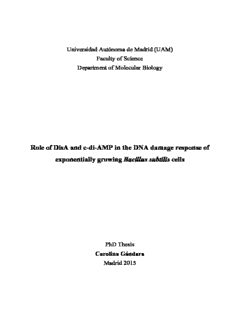
Role of DisA and c-di-AMP in the DNA damage response of exponentially growing Bacillus subtilis ... PDF
Preview Role of DisA and c-di-AMP in the DNA damage response of exponentially growing Bacillus subtilis ...
Universidad Autónoma de Madrid (UAM) Faculty of Science Department of Molecular Biology Role of DisA and c-di-AMP in the DNA damage response of exponentially growing Bacillus subtilis cells PhD Thesis Carolina Gándara Madrid 2015 Thesis presented by Carolina Gándara to obtain the degree of Doctor of Philosophy in Science at the Universidad Autónoma de Madrid (UAM), Madrid, Spain. This work has been performed at the Spanish National Biotechnology Centre (CNB-CSIC) under the supervision of Dr. Juan Carlos Alonso. Aos meus queridos pais Abstract Cells are constantly subjected to DNA lesions, which can result in replication fork stalling or collapse. A variety of DNA repair pathways have evolved to respond to the different types of exogenous and endogenous DNA damaging agents. A complex regulation exists to coordinate these processes, which are called DNA damage response (DDRs). DisA was initially described as a DNA damage checkpoint protein that ensures the genome integrity of Bacillus subtilis spores. However, basal levels of DisA were detected in vegetative cell extracts and highly dynamic foci were observed in vegetative cells expressing DisA-YFP under its native promoter. Since DisA is also present in non-spore forming bacteria, a more general role for DisA, that is not restricted to sporulation, was proposed. In this work, it was demonstrated that c-di-AMP and the diadenilate cyclases (DAC), DisA and CdaA, contribute to elicit repair of stalled and collapsed forks, in exponentially growing B. subtilis cells. Absence of DisA or decreased intracellular levels of c-di-AMP impaired survival to alkylation DNA damage induced by methyl methanesulfonate (MMS). On the other hand, CdaA is involved in oxidative damage repair. The radA and disA functions were epistatic for MMS and showed also epistasis with functions involved in Holliday junction (HJ) processing. Both radA and disA were epistatic with recG and recU, while non-epistatic with ruvAB. In vivo, DisA-YFP foci lost its dynamics in the presence of unresolved HJs (ΔrecU context). Purified DisA showed DAC activity with preference for ATP over dATP to produce c-di- AMP. DisA could bind different DNA structures without specificity, although only highly stacked HJs could modulate DisA c-di-AMP synthesis. For the first time it was demonstrated that RadA/Sms could bind DNA, in the absence or presence of ATP, and with more affinity for single-stranded (ss) DNA and HJs. In vitro assays showed that DisA strongly inhibits RecG and RuvAB helicase activities. DisA also negatively affects RecU resolvase activity and RecA- mediated strand exchange reactions. Altogether, these results indicate that, in stalled forks induced by the presence of alkyl adducts, DisA modulates the DDR by binding branched DNA and reducing the synthesis of c-di-AMP. More precisely, DisA modulates recombinational DNA repair by protecting branched recombination intermediates, and therefore preventing fork reversal, HJ resolution and strand exchange. It is likely that DisA stimulate other specific DNA repair pathways, such as BER, and favours TLS since slightly lower mutation frequencies were detected in the absence of DisA. Abbreviations AS Ammonium sulphate K Apparent dissociation constant Dapp ATP Adenosine triphosphate LB Luria-Bertani medium BER Base excision repair LC-MS/MS Liquid chromatography-tandem BSA Bovine serum albumin mass spectrometry c-di-AMP Cyclic diadenosine LC Lethal concentration to kill 99% 99 monophosphate MALDI-TOF Matrix-assisted laser CFU Colony-forming unit desorption/ionization time-of- CNB Centro Nacional de flight mass spectrometer Biotecnología min Minutes DAC Diadenylate cyclase MMC Mitomycin C DAPI 4’, 6-diamidin-2-phenylindole MMR Mismatch repair dATP deoxyadenosine triphosphate MMS Methyl methanesulfonate DDR DNA damage response Nal Nalidixic acid DDT DNA damage tolerance NER Nucleotide excision repair DMSO Dimethyl sulfoxide NHEJ Non-homologous end joining DNA Deoxyribonucleic acid Ni-NTA Nickel-nitrilotriacetic acid DNaseI Deoxyribonuclease I nt Nucleotides DSB Double-strand break OD Optical density dsDNA Double-stranded DNA PAGE Polyacrylamide gel DSS Disuccinimidyl suberate, electrophoresis Suberic acid PDE Phosphodiesterase DTT Dithiothreitol PEI Polyethyleneimine EDTA Ethylenediaminetetraacetic acid RNA Ribonucleic acid EMSA Electrophoretic mobility shift Rpm Revolutions per minute assay SDS Sodium dodecyl sulphate H O Hydrogen peroxide 2 2 ssDNA Single-stranded DNA HJ Holliday Junction SSG Single-strand gap HhH Helix-hairpin-Helix TAE Tris-acetate EDTA HR Homologous recombination TLS Translesion synthesis IPTG Isopropil-β-D-1- wt Wild-type tiogalactopiranósido YFP Yellow fluorescent protein kDa Kilo-dalton
Description: